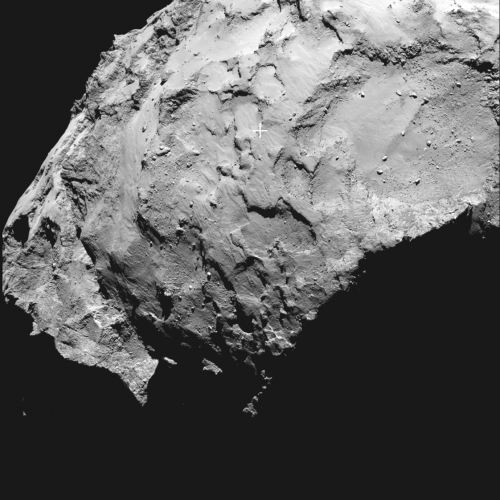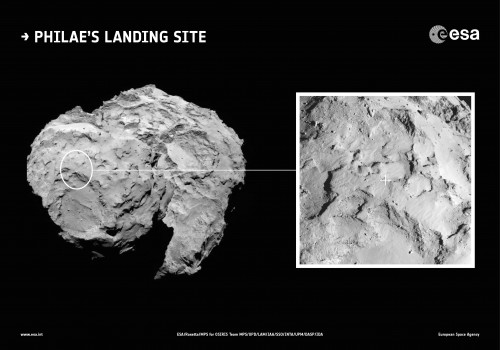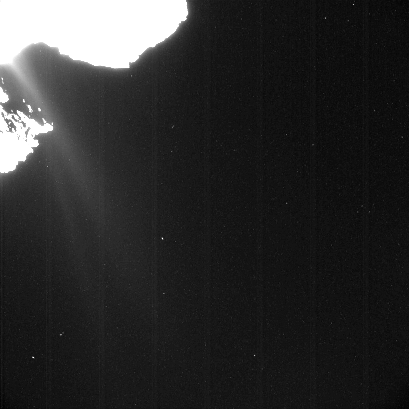
A landing site has now been chosen for the Rosetta spacecraft’s lander, Philae, on comet 67P/Churyumov–Gerasimenko, it was announced this morning. After several candidate landing sites had been considered, site J has now been selected for the daring landing later in November. It will be the first-ever attempt to actually land on a comet.
“As we have seen from recent close-up images, the comet is a beautiful but dramatic world – it is scientifically exciting, but its shape makes it operationally challenging,” said Stephan Ulamec, Philae Lander Manager at the DLR German Aerospace Center. He added, “None of the candidate landing sites met all of the operational criteria at the 100% level, but Site J is clearly the best solution.”

Site J is on the “head” of the double-lobed comet, in a location that offers the best combination of unique scientific potential, nearby jet activity, and minimum risk to the lander.
The lander itself weighs 100 kg and is scheduled to attempt the landing on Nov. 11, where it will be able to study the comet nucleus in unprecedented detail. According to Jean-Pierre Bibring, a lead lander scientist and principal investigator of the CIVA instrument at the IAS in Orsay, France: “We will make the first ever in situ analysis of a comet at this site, giving us an unparalleled insight into the composition, structure and evolution of a comet. Site J in particular offers us the chance to analyse pristine material, characterise the properties of the nucleus, and study the processes that drive its activity.”
The lander will descend autonomously to the surface, where it will then use harpoons and ice screws to secure it in place. After taking a 360˚ panoramic image of its surroundings, Philae will use its instruments to analyze the plasma and magnetic environment, as well as the surface and subsurface temperature of the comet. The lander even has a drill to acquire samples from below the surface. In a neat trick, Philae can send radio signals directly through the comet to communicate with Rosetta and analyze the interior at the same time.

Rosetta first arrived at the comet on Aug. 6, and has since been orbiting, acquiring breath-taking high-resolution images of the craggy, rough surface. It is now orbiting within 30 km of the surface of the 4km-wide comet.
Choosing the landing spot was not an easy task, as the surface of the comet is generally very rough, with many cliffs, boulders, and craters; smoother areas are fewer, but offer the safest possible terrain. Other factors, such as balance of daytime and nighttime hours and frequency of communication with the orbiter, also had to be considered.
“No one has ever attempted to land on a comet before, so it is a real challenge,” said Fred Jansen, ESA Rosetta mission manager. “The complicated ‘double’ structure of the comet has had a considerable impact on the overall risks related to landing, but they are risks worth taking to have the chance of making the first ever soft landing on a comet.”
There is a backup landing site, C, which also has adequate illumination from the Sun and few boulders, in the event that site J is no longer viable for some reason. A detailed operational timeline must now be prepared by the Rosetta team, in order to determine the specific trajectory the lander will take as it descends.
The landing must take place before mid-November, because after that the comet will start to become too active with its jets of water vapor and ice spewing out from the surface as it approaches closer to the Sun. Some activity has already been observed by Rosetta, with faint plumes emanating from the “neck” region of the comet.
As reportedly previously on AmericaSpace, Rosetta also recently took a cool “selfie” of itself with the comet in the background. The first preliminary scientific results have also been returned by Rosetta, which showed surprisingly less ice on the surface than expected.
The landing, if successful, will be the first time that a spacecraft has ever landed on a comet, with a view of the surface as never seen before. Godspeed, Philae!
Want to keep up-to-date with all things space? Be sure to “Like” AmericaSpace on Facebook and follow us on Twitter: @AmericaSpace
Missions » Rosetta »


